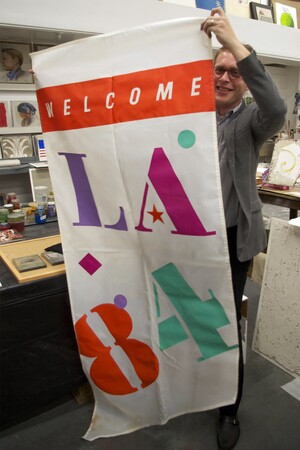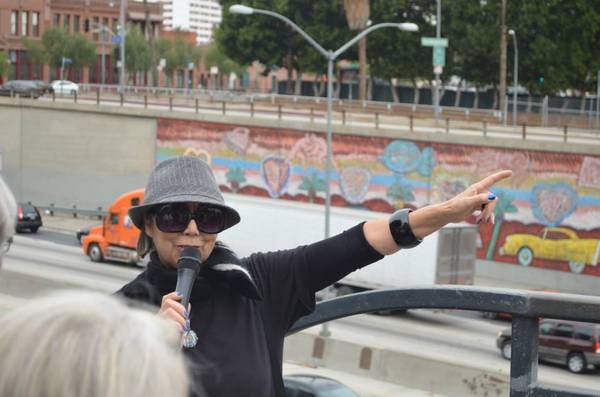L.A.'s 1984 Olympic Mural Team Reunited

The muralists who painted the walls for the 1984 Games exchanged hugs and stories last weekend like victorious Olympians.
By arrangement of The Mural Conservancy of Los Angeles, who has been restoring some of those works in time for the 30th Anniversary of the Olympic Games, Glenna Avila, Frank Romero, John Wehrle, Wille Herrón, Judy Baca, Kent Twitchell, Richard Wyatt, and Sheila Schoonhoven, widow of Terry, gathered at Twitchell's downtown studio.
Only Roderick Sykes and Alonzo Davis were unable to attend.
The artists were delighted to see Robert Fitzpatrick, the director of the Olympic Arts Festival, who listened to painter Alonzo Davis' initial idea of using murals for the massive arts exhibition. It was Davis who told him, "I got to show you something," recalls Fitzpatrick, and both Davis and Baca gave him a tour in places he otherwise would not have thought of visiting. "They took me to walls across various parts of the city," he said. "I said 'wow', this is fantastic communication."
From that introduction to paint on walls, Fitzpatrick believed Los Angeles murals had to be part of the festival. "This is an art form that came alive in Los Angeles. It came from a community on from the peripheral and it was accessible," he said, noting that the murals were not just to honor athletes or guests attending Olympic events; they were a way to present the region to the word and say "something special about the city."
Mayor Tom Bradley knew of the power of murals, but other city officials wondered, why give attention to something too close to being seen as graffiti?

To help make murals a public art component, Fitzpatrick first met with city politicians and said he had two proposals for a common man public art statement. "On Sunday afternoon at 1 p.m., the freeways would be allowed only red cars on the Santa Monica freeway, only green cars on the San Diego, and only blue cars on the Hollywood, and so on," said Fitzpatrick with a smile. "Then we do a overhead shot of the traffic congestion ... well, they were ready to toss me out. Then I said 'We have a better proposal; do commissioned (mural) art to show what its like to be in this city.'"
One person who resisted the idea of art on the walls of freeways was the same person who was overseeing the city's neighborhood mural program: Judy Baca.
"I was right about that," said Baca. "The freeway, I said, is no man's land. It's not a place to get a community to support us. And that is still the hardest part about the murals on the freeway."
But Fitzpatrick relented, and joked that Baca's protest of taking murals away from direct street access could be "more formidable" than city bureaucracy. But he relented because he saw the freeways of Los Angeles as the route to the Olympics and worthy of art, just as the paths in Olympia, Greece, once had statues.
"Los Angeles is only city in the world where the points of connections are along the freeways," said Fitzpatrick. "That's the only way to say to somebody that's how we are different, that's our DNA."
"I have to give him that," said Baca about Fitzpatrick's vision. "It was brilliant to see how the freeways and the mural are synonymous. That was important for the world to see."
Now many of the works are being restored by MCLA, and events and publications are being planned for an August commemoration in which the murals that MCLA were able to restore will be featured.
"The thing is when you are an artist who works on the street, it's a given it won't last forever," said Glenna Avila, whose "L.A Freeway Kids" was restored in 2013. "And that's the lot in how we loss for the murals, they were not funded for maintenance."
It's also a reconnection between the city, the games, and the art left behind. Other than Robert Graham's sculpture "Gateway at the Coliseum, the murals are the only artistic evidence that the games were held.
"It feels like a real reunion in part for us," said Avila. "And getting to see the murals in the best way possible"


(Top Photo) Back row: Glenna Avila, John Wehrle, Frank Romero, Willie Herron. Front row: Richard Wyatt, Judy Baca, Kent Twitchell, Robert Fitzpatrick, and Sheila Schoonhoven (widow of Terry Sheila Schoonhoven). Photo: Ed Fuentes


